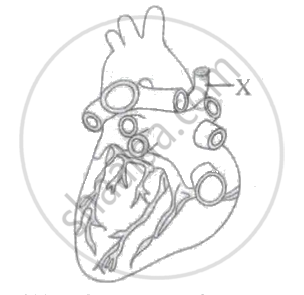Advertisements
Advertisements
प्रश्न
उत्तर
| ARTERY | VEIN |
| 1. It is a type of blood vessel having thick muscular walls . | 1. It is a type of blood vessels having thin muscular walls. |
| 2. It contains oxygenated blood. | 2. It contains deoxygenated blood. |
| 3. It carries blood away from the heart. | 3. It brinqs the blood to the heart. |
APPEARS IN
संबंधित प्रश्न
Fill in the blank.
___________ carry pure blood.
A muscular wall is absent in ______.
Name the Blood vessels entering liver and kidney and Blood vessels leaving liver and kidney.
The figures given below are cross-sections of blood vessels.
(i) Identify the blood vessels A, B, and C.
(ii) Name the parts labeled 1-4.
(iii) Mention two structural differences between A and B.
(iv) Name the type of blood A that flows (a) through A, (b) through B.
(v) In which of the above vessels referred to in (iv) above does exchange of gases actually take place?
Identify the CORRECT match.
Which blood vessel is indicated by 'X' in the following diagram?

Arteries and veins are connected by a network of extremely narrow tubes called:
Analogy:
Carries blood from the right ventricle to lungs: Pulmonary artery.
Carries blood from the lungs to left atrium: ______.
The substances to and from the tissues diffuse through the walls of ______.
Given alongside are diagrams of a certain category of blood vessels showing the role of a special structure in their walls. Study the figure and answer the questions that follow.
 |
- Name the kind of blood vessels shown in the figure. What are its branches termed as?
- Name the structure shown inside the blood vessels. Write its important role.
- What kind of blood flows through these blood vessels normally? Name the blood vessel which carries blood from the heart to the lungs.
- Name a similar kind of blood vessel which is related to the liver and kidney.
- Draw a neat and labelled diagram of the transverse section of the blood vessel shown above showing the three layers of its wall and lumen.
